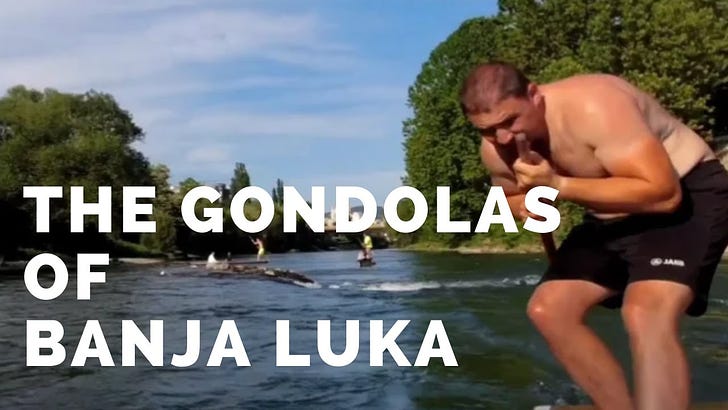Dajaks - The Gondolas of Banja Luka
A ride in Banja Luka's traditional boat, the Dajak, is a unique experience that you don't want to miss when you are in the city.
For most tourists a visit to Venice is incomplete without a ride in one of the Gondolas.
Now, the same rule applies when visiting Banja Luka. A ride in Banja Luka's traditional boat, the Dajak, is a unique experience that you don't want to miss when you are in the city.
The Dajaks, by the way is now the symbol for the city and you’ll see them not only in marketing products but also on roundabouts and other locations throughout the city.
The name Dajak comes from the wooden pole, some 4 meters long, that is used to push the boat against the current of the River Vrbas, where a paddle would not be helpful, because the river is not deep enough.
If you can’t subscribe to Coffee and Rakija, for whatever reason, and really would like access to all my content, please drop me a message.
The River Vrbas' current is notoriously fast.
Today, Dajaks are used within 15 kilometres of the city in the shallow sections of the River Vrbas.
Dajak's used to be bigger than they are today, and have been used for centuries to transport goods and people down the river.
Allegedly Banja Luka did not have too many bridges centuries ago hence using Dajaks in a commercial way. Once the bridges were built, they were taxed, so again Dajaks were a great commercial option for transporting.
In the late nineteen sixties Dajaks got a modern makeover. Today they are used for relaxation and sport. The person that steers the “Dajak" is called a “Dajakaš".
Dajaks are seven metres long and made from pine (fir). The most striking details are are on the stern and bow of the boat (spitz), which are made from one piece of wood.
Steering a Dajak is not very hard. It's just important to master the technique.
The traditional skills needed to both repair the Dajak boats and build new ones is now under threat. It seems that new generations are not too interested in learning the skills required.
Hopefully this won’t mean the end of this unique part of Banja Luka city culture.
So, when coming to Banja Luka in the late spring to late summer, do take advantage of the unique opportunity to get to know the city from the River perspective, along with an experienced “Dajakaše.
You won’t be disappointed.
If you need advice or help, the drop me a line:
📈 The Survey 📊
I have a short survey designed to improve my Substack. It would be super helpful if you could find under 5 minutes to complete it. Thanks so much in advance.
And Finally
Don’t forget that you can read back editions of the newsletter, listen to previous podcasts (we have quite an archive now), or catch other content, all this is available on the web interface, just like a regular blog.
Oh, and please share the newsletter with friends, relatives and colleagues using the button below.
Tamara and I appreciate your faithful readership, your comments, and your generosity!
Until our next post.
THANKS SO MUCH ❤️
As ever stay safe wherever you are.
Bests
David and Tamara.





